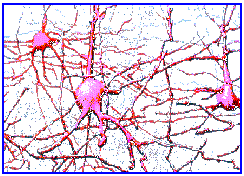Remote Ready Biology Learning Activities has 50 remote-ready activities, which work for either your classroom or remote teaching.
Serendip is an independent site partnering with faculty at multiple colleges and universities around the world. Happy exploring!

Welcome to the home page of Biology 202 at Bryn Mawr College.
TOPIC 1
It was asserted in class that "the brain is behavior ... there isn't anything else". If you are (appropriately) skeptical about this assertion, describe what aspects of behavior (including human experience) you think will not be accountable for in terms
of the organization and function of the nervous system, and explain why. If you are (equally appropriately) inclined to agree with the assertion, describe what aspects of behavior (including human experience) you think will be most difficult to make sens
e of in terms of the organization and function of the nervous system, and suggest how these might most usefully be explored.
TOPIC 2
The nervous system was considered as a large input/output box consisting of smaller interconnected input/output boxes, themselves consisting ... and so forth. Discuss the rationale and usefulness of this characterization for clarifying the relation betwe
en the nervous system and behavior.
OR
The behavior of a human paraplegic was used to argue that there existed within the nervous system a smaller box (the "I-function") whose activity corresponded to personal experience and action. Discuss the legitimacy and usefulness of this conclusion.
OR
It was suggested during discussion that the brain=behavior equivalence made it impossible to assert with certainty the existence of anything outside the nervous system. Discuss the validity and implications of this suggestion.
TOPIC 3
If brain=behavior, then things learned about nervous system structure and function might be expected to change how one thinks about behavior. In this respect, how significant is or is not a better understanding of such cell level processes as action pote
ntials and membrane potentials in general? If such understandings have changed the way you think about behavior, explain how and why. If not, discuss why you think they might or might not in principle do so.
TOPIC 4
Thinking of the nervous system in terms of "stimulus" and "response" inclines one to believe that what happens on one side of the nervous system in caused by what happens on the other, an idea which might, to some extent, persist even when replacing the t
erms "stimulus" and "response" with "input" and "output". In class, it was suggested that the organization of the nervous system actually yields bidirectional causation, with output affecting input as well as input affecting output. Discuss the legitimacy
and usefulness of this suggestion, and its possible significance for how one thinks about behavior.
TOPIC 5
"Central pattern generation" and "corollary discharge" are concepts which arise from observations on the motor side of the nervous system but which seem to have broader implications for thinking about behavior generally. Discuss the validity and more gen
eral implications of one or both of these concepts.
OR
"Motor systems" and "Integrating Systems: The Neural Basis of Behavior" are Parts IV and V of your textbook (Delcomyn, Foundations of Neurobiology) with "Sensory Systems" as Part III, whereas we have talked about "output systems" prior to discussing "inpu
t systems". Discuss the pros and cons of the two different approaches.
TOPIC 6
The "I-function" reared its head at the beginning of the course and again as we were talked about the output side of the nervous system. Discuss the extent to which this now appears to be a necessary concept for understanding the nervous system and a use
ful concept for understanding behavior.
OR
Negative feedback loops were discussed as both an important concept in understanding motor control and as a useful concept for thinking about behavior more generally. Discuss the basic ideas involved in this concept and its usefulness for understanding b
ehavior generally.
TOPIC 7
What lessons about perception and behavior generally come from considerations of the blindspot of the eye and/or from discussions of how a two-dimensional retinal image is transformed by the brain into a three-dimensional
perception?
TOPIC 8
Since you last wrote, we're talked about lateral inhibition and color vision, with a focus on the creation of categories by the brain, about blindsight and the issue of whether one needs a "picture in the head" to "see", and about frog orienting behavior
and "intrinsic variability". Which of these most affects how you think about the relation between brain and behavior, and why?
TOPIC 9
What new insights into the nervous system, behavior, and/or the relation between them come from discussion of sleep/wake behavior and related phenomena?
TOPIC 10
How about going back and rereading your first essay (or remembering what you would have said then if you didn't write one), and
then writing about what has, or has not, changed in your thinking about these matters over the semester?
| Course Home Page
| Back to Brain and Behavior
| Back to Serendip |